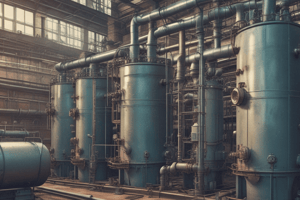Podcast
Questions and Answers
Which component is NOT categorized as a type of impurity in natural water?
Which component is NOT categorized as a type of impurity in natural water?
- Suspended Matter
- Dissolved Gases
- Pure Hydrogen (correct)
- Organic Impurities
What is the primary cause of water hardness according to the chemical composition of impurities?
What is the primary cause of water hardness according to the chemical composition of impurities?
- Nitrates
- Silicates
- Chlorides
- Carbonates and Sulfates (correct)
Which of the following substances is an example of a colloidal impurity?
Which of the following substances is an example of a colloidal impurity?
- Sodium Chloride
- Calcium Carbonate
- Organic Detritus
- Silica (correct)
How do atmospheric gases contribute to water impurities?
How do atmospheric gases contribute to water impurities?
Which statement about organic impurities in water is accurate?
Which statement about organic impurities in water is accurate?
What is a significant consequence of dissolved gases like O₂ in water?
What is a significant consequence of dissolved gases like O₂ in water?
Which of the following would NOT be a source of impurities in natural water?
Which of the following would NOT be a source of impurities in natural water?
What role do suspended matter such as clay and sand play in natural water?
What role do suspended matter such as clay and sand play in natural water?
Flashcards are hidden until you start studying
Study Notes
Impurities in Water
-
Chemically pure water is composed of two parts hydrogen and one part oxygen.
-
Natural water contains various impurities categorized as suspended matter, dissolved substances, colloidal impurities, and organic impurities.
Suspended Matter
- Inorganic suspended matter includes clay and sand.
- Organic suspended matter includes animal and vegetable matter.
Dissolved Substances
- Inorganic salts include carbonates, chlorides, and sulfates of calcium & magnesium.
- These salts cause water hardness.
- Calcium & magnesium bicarbonates dissolve in water when it passes through dolomite or limestone in the presence of air.
- CaCO₃ + H₂O + CO₂ → Ca(HCO₃)₂
- MgCO₃ + H₂O + CO₂ → Mg(HCO₃)₂
- Dissolved gases in water include CO₂, N₂, O₂, and H₂S.
- CO₂, N₂, O₂, and H₂S can cause odor and acidity.
- O₂ can also cause corrosion in boilers.
- Other dissolved salts include sodium, potassium, iron, manganese, silica, and alumina.
- Some trivalent cations like Fe and Al may be present.
Colloidal Impurities
- Finely divided substances not visible to the naked eye.
- Includes silica, clay, aluminum hydroxide, and microorganisms.
- Can cause color, odor, and diseases.
Organic Impurities
- Includes algae, fungi, plant matter, and microorganisms (bacteria being animal in origin).
Sources of Impurities
- Rainwater floods carry floating impurities.
- Atmospheric gases like CO₂, O₂, etc. are absorbed into water.
- Water percolating through the soil dissolves salts like calcium, magnesium, and sodium.
- Decomposition of organic matter from plant and animal remains, sewage, and industrial waste introduce organic impurities.
Effect of Impurities
Domestic Purposes
- Hardness caused by dissolved salts of calcium and magnesium prevents soap from forming lather.
- Soap is essentially a mixture of sodium and potassium salts of higher fatty acids.
Studying That Suits You
Use AI to generate personalized quizzes and flashcards to suit your learning preferences.




